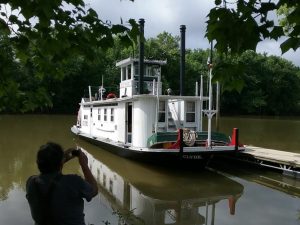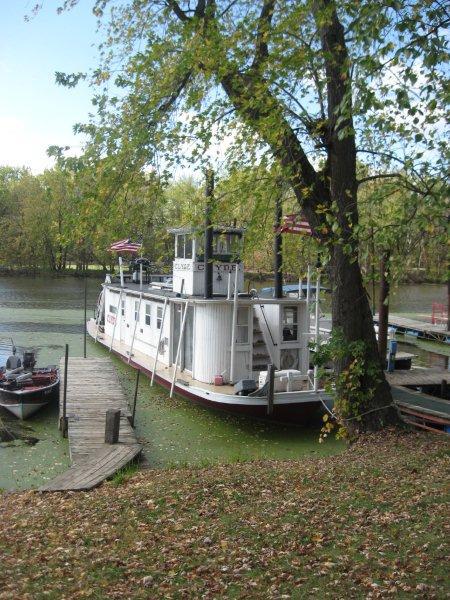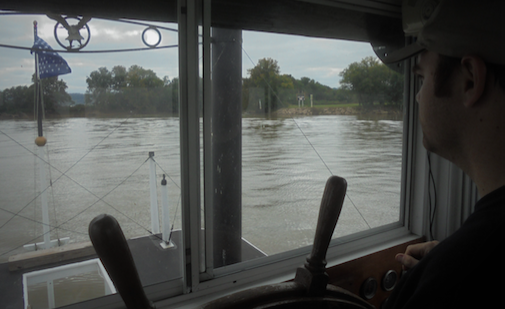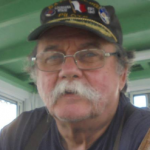The riverboat captain is a storyteller, and Captain Don Sanders will be sharing the stories of his long association with the river — from discovery to a way of love and life. This a part of a long and continuing story.
By Capt. Don Sanders
Special to NKyTribune
If one sentence could best describe my general attitude about life, it might be:
“I hate change!”
Change, though, is inevitable; the world is in constant flux. Still, I want the patterns in my life to remain constant without variations: especially those that give warm, fuzzy feelings in all the right places. As difficult as it is for me to say; much-less commit to writing, I am on the threshold of a significant life change I must face.
For specific personal reasons, it is time to find a new caretaker, i.e., Owner, for my paddlewheeler, the Rafter CLYDE, the most authentic-looking replica sternwheeler on the river.
There… I said it! The CLYDE. is available for purchase to the “right” person(s).

It is time to find a new caretaker, i.e., Owner, for my paddlewheeler, the Rafter CLYDE, the most authentic-looking replica sternwheeler on the river.
The Rafter CLYDE is the largest working model of a 1870s steamboat of the type that towed rafts of first-growth Wisconsin Pine from the Mouth of the Chippewa River, above Alma, Wisconsin on the Upper Mississippi, to sawmills as far south as St.Louis – nearly six-hundred miles by water. The original steamboat CLYDE, built at the Iowa Iron Works in Dubuque, Iowa in 1870 as a sidewheeler, was the first iron-hulled (as opposed to wood) steamer on the upper river. Built under the supervision and scrutiny of a displaced Scotsman named William P. Hopkins who learned his art building metal ships on the River Clyde, it was the most technologically-advanced vessel of its time. Naming the steamboat for Mr. Hopkins’ ancestral river honored him for his accomplishments as a boatbuilder.
Ed Newcomb, a descendant of several Newcomb men who crewed the original namesake, built the latest version of the CLYDE in his backyard on the banks on Lake Pepin, the only naturally-occurring lake on the Great American River. Under the guidance of the celebrated marine architect, Captain Alan Bates, Newcomb made his reproduction as historically-accurate as possible. If after consulting Captain Bates about whatever it was Ed had in mind wasn’t correct, the offending part, piece, or section was torn out and rebuilt to satisfy the master maritime designer whose steamboat masterpiece is the Steamer NATCHEZ of New Orleans. Or as noted in the September 2004 issue of Heartland Boating magazine:

The original steamboat CLYDE, built at the Iowa Iron Works in Dubuque, Iowa in 1870 as a sidewheeler, was the first iron-hulled (as opposed to wood) steamer on the upper river.
“Ed knew the general shape and design of CLYDE from pictures he had and then relied on a book called “The Western Rivers Steamboat Cyclopoedium’ by Alan L. Bates for help with details.”
The mag, also known as “Mid-America’s Premier Boating Magazine,” also observed:
“… the tricky part of the construction was making sure it looked like an old boat. The book helped with that problem… the book has lots of information about proportions in general.”
Combining the talents of the famed maritime architect and a gifted builder, the resulting CLYDE is undoubtedly the most authentic and finest-proportioned sternwheel steamboat replica anywhere on the Western Rivers.
Seeing the CLYDE for the first time, rubes invariably remark,
“I’ll bet ya got propellers underneath the hull.”
Sorry, but there are no props hidden below the water. Instead, one of the most authentically built wooden paddlewheels in existence shoves the CLYDE through the water. Every White Oak part is individually crafted, and except for the Wheel Arms radiating out from a central shaft like spokes, no two pieces are exactly alike.

The CLYDE featured on the cover of Heartland Boating.
Within the engine compartment inside the steel hull, a mighty 35 HP, four-cylinder, Kubota diesel engine drives two hydraulic pumps. The largest is an Eaton VS primary drive pump and the smaller is an accessory pump for the steering and the bow-thruster.
The CLYDE has a thirty-gallon plastic holding tank for the head. The fuel capacity is twenty-eight gallons in each of the two bow tanks (also plastic) and a twenty-five-gallon engine holding day tank (aluminum), located under the deck next to the engine. The potable water tank holds some fifty-gallons.
The paddlewheeler boasts of a full galley, or kitchen, alongside an oak dining table. A complete “head” with toilet, shower, and a sink are as lovely as any boat owner could want. Three twin-size beds, two of which are in the spacious Captain’s Quarters allows for overnight comfort on extended trips or just when spending a relaxing night onboard.
In the nearly seven years since CLYDE completed a 1,300-mile river trip from Alma to Aurora, Indiana, she’s been practically rebuilt from the top of the twin stacks to the bottom of the keel. But understand, above the recently repainted steel hull with the addition of a new bow thruster tube, the wooden superstructure always has some touch-ups to keep a classic boat enthusiast occupied. If working on a boat is not considered your concept of pleasure, the CLYDE is not the one for you. The prospective new owner must be willing to sign “The Pledge,” written by Ed Newcomb on the inside of the door in the aft passageway:
“CLYDE. is a fair boat. Take care of her.”

I fell in love with the CLYDE the first time I saw this picture of her docked at Alma, Wisconsin.
Handling-wise, the CLYDE acts like an old-time steamboat in the way she steers, backs, and turns around. From the authentic pilothouse, the view forward appears precisely like what Captain Horace E. Bixby, Mark Twain’s mentor, likely witnessed from behind the breast board of the palatial steam packet, the CITY of ST. LOUIS, in the 1880s. Everything about the CLYDE closely resembles a steamboat of the 19th Century except it’s much smaller and a diesel engine powers the sternwheeler rather than steam.
A word of caution for the curious “tire-kickers” interested in looking with no intentions beyond that, is… the CLYDE is not the boat for everyone. With no handrails, it is, as previously stated, a working model of a 19th Century raft boat and not friendly to the inexperienced greenhorn, small children, or the infirmed. That is not to say that modifications couldn’t be made in keeping with the original intent of the character of the vessel to make it adaptable to those mentioned above. That would be up to the buyer, but if a “houseboat” is all someone is seeking, many brands of new and used boats are always on the market.
Again, the refrain, “Not the boat for you.”
Let’s be realistic, a boat like the CLYDE isn’t cheap. Building a duplicate might cost a quarter-million dollars. Purchasing any boat is only the beginning. Then there are licensing fees, taxes, insurance, marina fees, maintenance, fuel, repairs, and a zillion unexpected costs. It’s much like the old saw, “B.O.A.T means, ‘Bring On Another Thousand.’” Only trouble these days, a thousand ain’t what a thousand used to be.
So how much would it take to become the third owner of the Rafter CLYDE? Let’s just say I refuse to take a penny over one-hundred thousand dollars and will negotiate from there. The CLYDE. has its own Facebook page so any preliminary contact can be made through the message box after LIKING the page at here.
Change, whether welcomed or not, is inevitable. And like it or not, it is time for a change.

From the authentic pilothouse, the view forward appears precisely like what Captain Horace E. Bixby, Mark Twain’s mentor, likely witnessed from behind the breast board of the palatial steam packet, the CITY of ST. LOUIS, in the 1880s.

Like it or not, it is time for a change.
Captain Don Sanders is a river man. He has been a riverboat captain with the Delta Queen Steamboat Company and with Rising Star Casino. He learned to fly an airplane before he learned to drive a “machine” and became a captain in the USAF. He is an adventurer, a historian, and a storyteller. Now, he is a columnist for the NKyTribune and will share his stories of growing up in Covington and his stories of the river. Hang on for the ride — the river never looked so good.
Click here to read all of Capt. Don Sanders’ stories of The River.


























I hate change too. What a difficult decision this had to have been. No boat out there could ever have received as much care, devotion and love with every nail and screw placed, with every weld done, with every stroke of a paintbrush and every pass of a cloth polishing any number of things in need of shining. The history, both personal and otherwise, preserved upon the Clyde speaks volumes. No, the Clyde isn’t the boat for everyone, because it has been lovingly and respectfully cared for by Captain Don Sanders, and that, like the Clyde, is something else! If only we could turn back time.
Oh my! I too hate change but am praying the right “next generation””will come along. Would it be possible do you yhink for a couple of younger river folk to combine time & resources to guve her the tlc she deserves. God bless.
Were I a Lot Younger with a lot more $Money, I would consider. Capt. Don says it that were true of him, He wouldn’t Sell. If I had the $Money I would consider Financing someone like (now) Capt. Alex. who we know can steer Clyde.